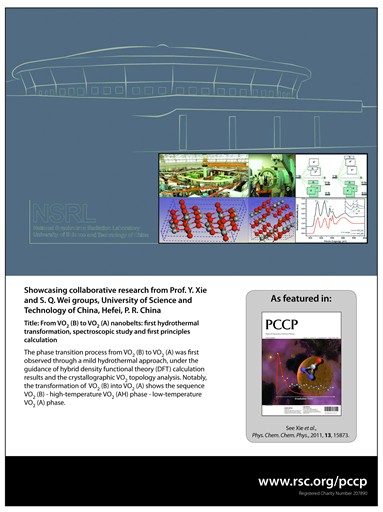Superior thermoelectric materials rely on high electrical conductivity, high Seebeck coefficient and low thermal conductivity. All these three factors are highly correlative to electronic structure and carrier-related properties. In the correlation system, active control and manipulation of the charge and spin degrees of freedom of the electrons as well as the atomic orbital orientations would create the expected electronic structure and charge carrier-related properties.
Based on concerns above, Prof. Yi Xie research group in University of Science and Technology of China highlights a new pathway to modulate strong correlation effect in rutile VO2(R) structure. The carrier concentration can be effectively controlled only by the injection of additional electrons into rutile V–O frameworks. Exterior modification using the lightest hydrogen atoms , without changing the V–O framework of rutile VO2(R), successfully stabilizes nonambient metallic VO2(R) phase at room temperature, with the lightest H+ ions contributing the additional electrons into the infinite V4+–V4+ chains and thus enhancing the electron–electron correlation effects in rutile structure. By controlling the hydrogen concentrations, metallic rutile VO2(R), semiconducting monoclinic VO2(M), and their intermediate states, the mixture of metallic VO2(R) and semiconducting VO2(M) (VO2(M-R)) polymorphs are all achieved at room temperature with carrier concentration gradients. In order to confirm that hydrogen incorporation does not change rutile V–O frameworks, the research group adopts synchrotron radiation X-ray Absorption Fine Structure (XAFS) spectrum to further reveal the local structure information of samples. Of note, the structure transition from monoclinic VO2(M) to rutile VO2(R) is just the V4+–V4+ atom chains projected along c-axis shifting from zigzag to linear, causing very similar structure character of these two phases. The XAFS spectra gives a solid evidence to prove that H+ incorporation can stabilize nonambient metallic VO2(R) to room temperature without changing V–O frameworks.
Since the change of carrier concentration would influence the thermoelectric effect significantly, this new way of controlling carrier concentration through regulating strong correlation effect in VO2 system is very important to the application of thermoelectric materials. The electric structure and carrier-related properties achieved via modulating correlation effect lead to the improved thermoelectric performance of stabilized metallic rutile VO2(R) in a wide working temperature range, especially in near or below room temperature. This finding reveals that regulating the electron–electron correlation effects in solids allows advances in controlling carrier concentrations, with promising signs for designing new thermoelectric materials. The related research result was published on the Journal of American Chemical Society (2011, 133, 13767) and selected as the cover article, which is so far the very few one of China mainland.

(a) Evolution of the transition temperature, Tc, with change in hydrogen concentration and (b) The cover picture of the work published on J. Am. Chem. Soc. (2011, 133, 13767)
Professor Yi Xiegroup has been focusing on the realization of controllable synthesis of vanadium oxides metal–insulator transition materials and regulating their properties, as well as designing new vanadium oxides functional materials. Furthermore, the relationship between crystallographic and electronic structure has been investigated systematically by XAFS and other characterization techniques. For instance, the electronic structure relevance of VO2(A) and VO2(B) was studied through XAFS spectra for the first time by the group, which provide a crucial experimental data to understand the physical and chemical properties of these two polymorphs. This work was published on Phys. Chem. Chem. Phys. (2011, 13: 15873) and invited as the back cover.

The back cover picture of the work published on Phys. Chem. Chem. Phys. (2011, 13: 15873)
QQ截图20131115153629.jpg